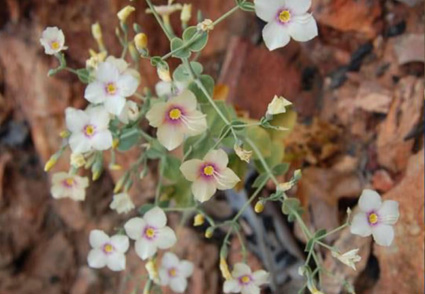Abstract
Symphyllophyton (Gentianaceae) is characterized by autotrophic herbs, with tetramerous flowers didynamous stamens, filaments attached to the distal portion of the corolla tube and connate-perfoliate or free leaves. The finding of a new population in the Brazilian State of Goiás inspired a detailed and unprecedented study of the genus, which lead to the discovery of four new species in different States and to the repositioning of Schultesia sucreana within the genus, thus elevating the known number of species from two to seven. A lectotype is designated for the genus. Descriptions, illustrations, and an identification key are provided along with notes on ecology and conservation.
References
<p>Aublet, J.B.C.F. (1775) [<em>Symphyllophyton</em>] <em>Histoire des Plantes de la Guiane Françoise</em> 1: 72, t. 27. Pierre-Francois Didot, London & Paris</p>
<p>BFG. (2015) Growing knowledge: an overview of seed plant diversity in Brazil. <em>Rodriguesia</em> 66: 1–29.</p>
<p>Berchtold, B.V. von & Presl, J.S. (1820)<em> O Prirozenosti Rostlin. </em>Krala Wiljma Endersa, Prague, 256 pp.</p>
<p>Chamisso, L.K.A. von & Schlechtendal, D.F.L. von. (1826) <em>Linnaea</em> 1: 195.</p>
<p>Don, G (1838)<em> A General History of the Dichlamydeous Plants</em> 4.</p>
<p>Endlicher, S.F.L. (1838) <em>Genera plantarum.</em></p>
<p>Gilg, E. (1897) <em>Symphyllophyton. In: </em>Engler, H.G.A. & Prantl, K.A.E. <em>Die Natürlichen Pflanzenfamilien</em> I: 283.</p>
<p>Gilg, E. (1898) <em>Symphyllophyton</em>. <em>In: </em>Engler, H.G.A. <em>Beibl. Bot. Jahrb.</em> 60: 43.</p>
<p>Gilg-Benedict, C. (1936) <em>Notizblatt des Botanischen Gartens und Museums zu Berlin-Dahlem</em> 13: 383. https://doi.org/10.2307/3994911</p>
<p>Grisebach, A.H.R. (1849) <em>Xestaea.</em> <em>Linnaea</em> 22: 35.</p>
<p>Guimarães, E.F. & Fontella, J. (2001) Estudos em Gentianaceae II. Espécies novas para o gênero <em>Schultesia</em> Mart. <em>Bradea </em>8 (35): 215–219.</p>
<p>Jussieu, A.L. de (1789)<em> Genera Plantarum. </em> </p>
<p>Linnaeus, C. (1753) <em>Species Plantarum. </em>Impensis GC Nauk.</p>
<p>Martius, C.F.P. von (1826) <em>Nova Genera et Species Plantarum</em> vol. 2, part 2. pp. 103–104.</p>
<p>Miller, P. (1735) <em>The Gardeners Dictionary containing the methods of cultivating and improving the kitchen, fruit and flower garden as also the physick, wilderness, conservatory and vineyard. </em>Abridged...fourth edition. Vol. 1. https://doi.org/10.5962/bhl.title.28437</p>
<p>Siqueira, G.B., Santo, F.S.E. & Rapini, A (2014) Flora da Bahia: Gentianaceae. <em>Sitientibus série Ciências Biológicas</em> 14. https://doi.org/10.13102/scb295</p>
<p>Struwe, L. & Albert, V.A. (eds.) (2002) <em>Gentianaceae: Systematics and Natural History</em>. Cambridge University Press. https://doi.org/10.1017/CBO9780511541865</p>


